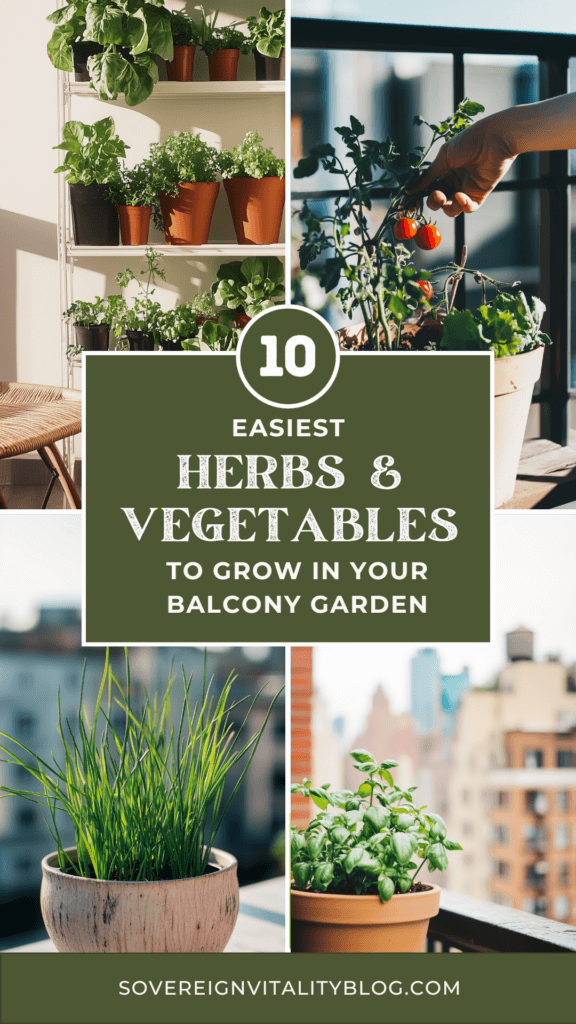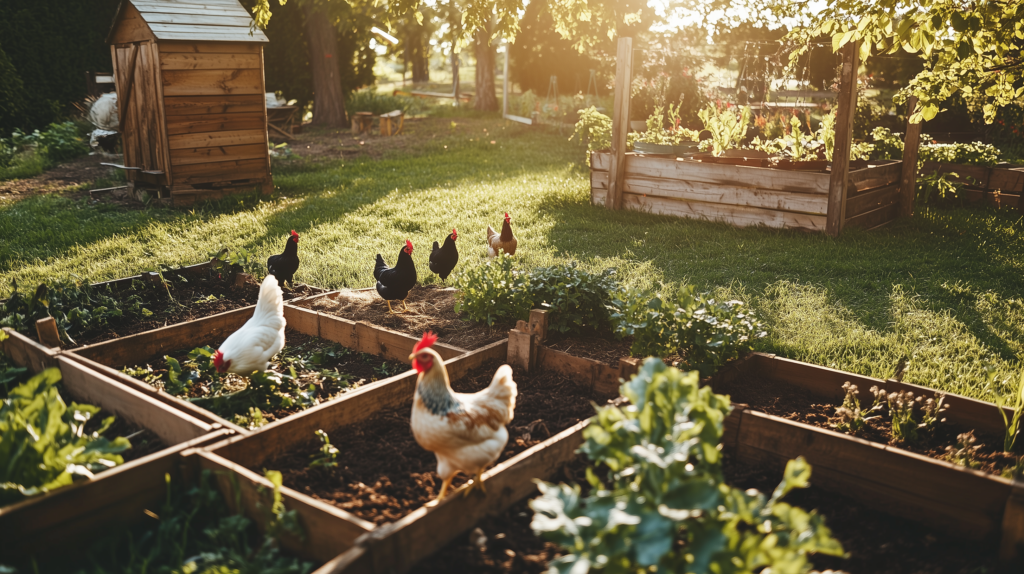This post may contain affiliate links, including those from Amazon Associates. If you make a purchase through these links, I may earn a commission at no additional cost to you. Learn more about our affiliate policy.
I used to think my tiny balcony couldn’t handle a garden. But after a bit of trial and error, I discovered that with just a few pots and the right plants, I could grow fresh produce right outside my door. Now, stepping onto my balcony feels like entering my very own mini farmer’s market. It’s a game-changer!
If you’ve ever felt like limited space or lack of experience is holding you back, trust me, I’ve been there. But I’ve also learned a few balcony vegetable gardening secrets that make it so much easier to get started. And if you’re curious about taking it a step further, you can explore even more creative ways to homestead in an apartment.

In this post, I’ll share 10 of the easiest vegetables and herbs you can grow on your balcony. These plants are low-maintenance, beginner-friendly, and perfect for transforming even the smallest spaces into a flourishing balcony garden.
Why Start a Balcony Garden?
A balcony garden is more than just a way to grow vegetables, it’s a quality of life upgrade. Imagine stepping onto your balcony and being greeted by the vibrant greens of lettuce or the earthy scent of fresh basil. Beyond the aesthetic and sensory benefits, a balcony garden also gives you more sovereignty over your food choices.
By growing your own produce, you’re not only ensuring fresher, healthier options for your meals, but also reducing your reliance on the conventional food system. This means fewer worries about pesticides, long supply chains, or lackluster supermarket veggies. Here are just a few reasons why starting a balcony garden is worth it:
- Fresh Produce: Enjoy the unbeatable flavor of homegrown vegetables and herbs, picked fresh when you need them.
- Improved Air Quality: Plants naturally purify the air, making your balcony a healthier and more refreshing space.
- A Therapeutic Hobby: Gardening is a calming, stress-relieving activity that helps you connect with nature, even in the middle of the city.

Myths About Space Limitations
One of the biggest misconceptions about balcony gardening is that you need a large outdoor space to grow anything worthwhile. The truth? Many vegetables and herbs thrive in compact containers. With clever use of vertical planters and railing baskets, even the smallest balcony can become a productive garden. Here are some DIY balcony garden projects to help you get started.
Tips for Getting Started
Start small. It’s tempting to dive in and fill your balcony with plants, but beginning with just a few easy-to-grow varieties will help you build confidence and keep things manageable. Choose plants that suit your lifestyle and growing conditions. This guide will help you identify some great options.
Plan Your Layout
Before you start planting, take some time to envision how you’ll use your space. Observe how much sunlight your balcony gets throughout the day, as most vegetables and herbs need at least 4–6 hours of sunlight. Identify the sunniest spots for plants that love light, like tomatoes or peppers, and use shaded areas for herbs like mint or parsley that tolerate lower light levels.
Think about vertical space, too. Hanging baskets, railing planters, and tiered shelves are excellent options for maximizing your balcony’s potential. For example, you can grow cascading herbs like thyme in a hanging basket while reserving railing planters for leafy greens or compact vegetables.
Experiment with Setups
Don’t be afraid to try different arrangements to see what works best. Group plants with similar needs together for easier care—herbs that prefer dry conditions like thyme and basil can share a spot, while water-loving greens like lettuce can be placed nearby for more frequent watering.
Start Observing Early
Pay attention to your plants as they grow. Are the leaves reaching toward the light? Are some areas too shaded or windy? Making small adjustments as you go will ensure your plants thrive and help you learn what works best in your unique space.
Top 5 Vegetables for Your Balcony Garden
Growing vegetables on your balcony is easier than you might think. These five are perfect for small spaces and beginners alike:
Cherry Tomatoes

Compact and high-yielding, cherry tomatoes are a balcony favorite. A single plant can produce an impressive harvest, and their vibrant colors add a decorative touch to your space.
How to Grow: Plant cherry tomatoes in a container at least 12 inches deep. Place them in a sunny spot, as they need at least 6–8 hours of direct sunlight daily. Use a cage or stake for support as the plant grows.
Pro Tip: Water deeply but infrequently to encourage strong roots, and pinch off suckers (small shoots between the main stem and branches) for better airflow and fruit production.
Radishes

If you’re new to gardening, radishes are the perfect crop to start with. They grow fast, often ready to harvest in just a few weeks, and don’t require much space.
How to Grow: Plant radish seeds about 1/2 inch deep in a container that’s at least 6 inches deep. Place the pot in a spot with full sunlight, and keep the soil evenly moist.
Pro Tip: Radishes grow best in cool weather, so start them early in the spring or in the fall for the best results.
Peppers
Peppers, whether sweet or spicy, are compact plants that do well in pots. Their bright, colorful fruits not only taste amazing but also add a pop of color to your balcony garden. You can also quick pickle them for a sweet and tangy treat.
How to Grow: Use a container at least 10–12 inches deep with nutrient-rich potting soil. Peppers thrive in full sun and need 6–8 hours of direct light daily. Keep the soil moist but not soggy.
Pro Tip: Fertilize with a balanced vegetable fertilizer every few weeks to encourage healthy growth and vibrant fruits.
Lettuce

Lettuce is a superstar for balcony gardens. It grows quickly, thrives in shallow containers, and can be harvested multiple times throughout the season. Plus, there’s nothing better than fresh greens for your salads!
How to Grow: Use a container at least 6 inches deep with good drainage. Lettuce prefers partial sunlight, making it ideal for balconies that get morning sun and afternoon shade. Sow seeds directly into the soil and keep it consistently moist.
Pro Tip: Harvest the outer leaves first to encourage continued growth, giving you fresh greens for weeks.
Green Beans
Green beans are climbers, making them ideal for vertical gardening. Provide them with a trellis or support, and they’ll use your balcony’s vertical space efficiently while rewarding you with tasty pods.
How to Grow: Plant green beans in a container that’s at least 12 inches deep and provide a sturdy trellis or stake. They need full sun (6–8 hours daily) and well-draining soil.
Pro Tip: Harvest pods regularly to keep the plant producing and prevent beans from becoming tough.
Top 5 Herbs for Your Balcony Herb Garden
Herbs are a fantastic way to get started with a balcony garden. They’re easy to grow, require little maintenance, and liven up your cooking with fresh, aromatic flavors. You can also get started with these indoors on a sunny windowsill.
Basil

Basil is a fragrant favorite that pairs beautifully with tomatoes, pasta, and pesto. Its vibrant green leaves bring both flavor and beauty to your garden.
How to Grow: Plant basil in a container at least 6 inches deep. It thrives in full sunlight, so place it in the sunniest spot on your balcony. Keep the soil moist but not soggy, and pinch back leaves regularly to encourage bushy growth.
Pro Tip: Avoid letting basil flower, as it can turn the leaves bitter. Pinch off flower buds as soon as they appear.
Parsley
Parsley is a versatile and nutrient-packed herb that’s easy to grow and a staple in many kitchens. Its bright, fresh flavor is perfect for salads, sauces, and garnishes.
How to Grow: Use a container that’s at least 8 inches deep. Parsley does well in partial shade and needs consistent moisture to thrive. Start with seeds or small transplants, and harvest leaves from the outer edges of the plant.
Pro Tip: Parsley grows slowly at first but will thrive with regular watering and occasional feeding with a balanced fertilizer.
Chives

Chives are a low-maintenance herb that’s perfect for small spaces. Their mild onion flavor works well in salads, soups, and baked dishes. Plus, their delicate flowers add beauty to your garden.
How to Grow: Plant chives in a container at least 6 inches deep with well-draining soil. They thrive in full sun but can tolerate partial shade, making them versatile for balconies with varying light conditions.
Pro Tip: Harvest chives by snipping leaves close to the base, encouraging new growth. The purple flowers are also edible and make a beautiful garnish!
Thyme
Thyme is a hardy, low-maintenance herb with earthy, savory flavors that enhance soups, roasts, and vegetables. Its delicate leaves thrive in small spaces.
How to Grow: Plant thyme in a shallow container with well-draining soil. It prefers full sun but can tolerate partial shade. Water sparingly, as thyme thrives in slightly dry soil conditions.
Pro Tip: Thyme is a low-maintenance herb that pairs beautifully with both savory dishes and teas.Compact and fragrant, thyme is a fantastic herb for small spaces. Its woody stems and tiny leaves pack a punch of flavor, making it a favorite for roasted dishes and marinades.
Mint

Mint is a vigorous grower that adds a refreshing touch to drinks, desserts, and savory dishes. Its hardiness makes it an ideal choice for balcony gardens.
How to Grow: Mint is incredibly hardy and can thrive in partial shade. Use a deep container to prevent its roots from spreading and overtaking other plants. Keep the soil moist and harvest leaves frequently to encourage new growth.
Pro Tip: Mint’s aggressive growth makes it best suited to a pot by itself, away from other herbs.
Final Thoughts on Balcony Vegetable and Herb Gardening
Growing vegetables and herbs on your balcony is easier than you think, and so worth it. With these easy to grow plants, the right tools, and a little bit of care, you can transform even the smallest space into a nourishing garden.
Start small. Choose a few plants you love, experiment with setups, and enjoy the simple joy of harvesting your own fresh produce. Before you know it, your balcony garden will become a source of pride, relaxation, and incredible flavor.
Frequently Asked Questions About Balcony Vegetable and Herb Gardening
Can I really grow vegetables and herbs on my balcony?
Yes! Even small balconies can become productive mini-gardens with the right approach, containers, and plant selection
How much space do I need to start a balcony garden?
You can start with just a few containers. Even a 4×6 foot balcony can produce a surprising amount of herbs and small vegetables.
Will my balcony support the weight of a garden?
Always check your building’s weight restrictions. Use lightweight containers, potting mix, and choose plants strategically to minimize weight.
What are the best containers for balcony gardening?
Look for lightweight materials with drainage holes, typically 8-12 inches deep for most herbs and vegetables.
How much sunlight do balcony herbs and vegetables need?
Most edible plants require 6-8 hours of direct sunlight for fruiting vegetables, and 4-6 hours for herbs and leafy greens.
Which herbs and vegetables grow best on a balcony?
Top herbs include basil, mint, rosemary, and chives. Best vegetables are cherry tomatoes, peppers, lettuce, and compact cucumber varieties.
Can I grow plants vertically on my balcony?
Yes! Use trellises, hanging planters, tiered shelving, and wall-mounted planters to maximize space.
How often should I water balcony plants?
Check soil moisture daily and water when the top inch feels dry, adjusting for plant type, container size, and weather conditions.
What if my balcony gets limited sunlight?
Consider shade-tolerant herbs, use grow lights, create reflective surfaces, and rotate plants to maximize available light.



